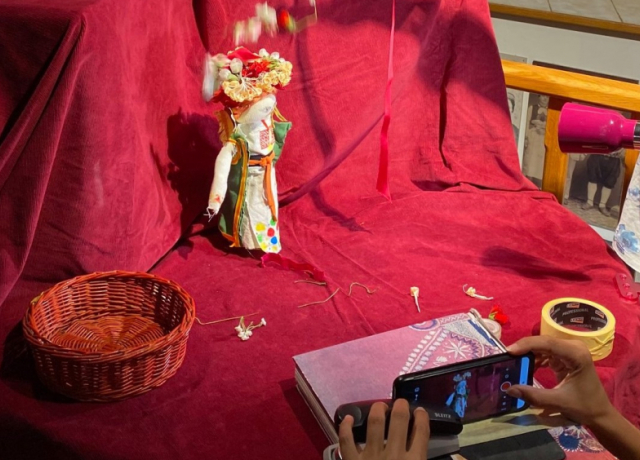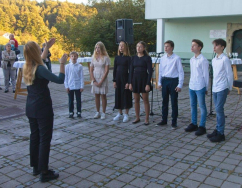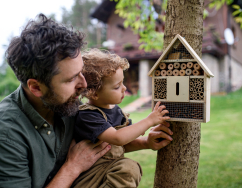European Heritage Days Article:
Creative Event Ideas for the Living Heritage Theme
European Heritage Days Article:
Creative Event Ideas for the Living Heritage Theme
Photo: Stop animation workshop for children EHD event 2021; credits: Konavle County Museum, Cilipi, Croatia
Host performances and demonstrations
An event programme based on the Living Heritage theme could potentially include a huge range artistic entertainment as the performing arts are recognised as a significant element of the scope of intangible heritage. Music is one example, whether that’s instrumental performances or singing, and traditionally this is often intertwined with other cultural channels such as dancing or social rituals and festivities. Theatre is another type of performance which can combine several art forms, as well as covering specific genres such as puppetry and pantomime. Oral traditions are also particularly key when defining intangible heritage, so it’s worth looking at whether spoken language performances such as poetry reading, riddle-telling or legendary storytelling can be included in events.
Demonstrations of traditional crafts showcase a different kind of creative output. While objects and art are tangible, both the knowledge and skills used in their creation and their significance and meaning are often inextricably linked to intangible learning and culture, so this can be a helpful approach to the theme. Think about the variety of crafts which visitors would be interested in learning about such as pottery or jewellery making, and especially focus on any local specialities such as glass blowing or clog and lace making. In fact, traditional clothing is great way to explore craft skills, whether that’s demonstrations of dying fabrics, sewing and embellishing, or even putting on a fashion show.
Encourage everyone to get involved
Participatory involvement is a great way to think about putting Living Heritage into practice. Getting in touch with local communities, clubs and groups can help encourage them to design their own events for the theme to share their experiences and living knowledge. For example, cookery lessons could use nearby produce and focus on recipes from the archives to produce local specialities and would be a great way for a family-run restaurant or community group to get involved. Cultural institutions such as museums, libraries and galleries are also often keen take part through special exhibitions or offering their expertise or other resources.
For the visitors themselves, workshops and interactive activities often prove popular. Some ideas which could be held in a variety of venues would be teaching how to paint traditional designs or learning dance routines… why not try a tour of these classes at schools and retirement homes to get people of all ages involved? Other types of engaging events might include competitions or contests, such as video-making or photography on the topic of living traditions… and perhaps an awards night for these might make a fun closing ceremony to this year’s events!
Consider events with venues and props
When planning performances, an interesting aspect to bear in mind is the context in which these are performed. Many aspects of Living Heritage are linked to specific life events or situations such as music for weddings which might be best showcased in a religious building, or storytelling, nursery rhymes and lullabies for young children which could be linked to a library or school. Another way to add context to performances, such as poetry recitals, is to produce these in historic places connected to the origin or age of the poems, or to look for ways to work with museums which may have exhibits or costumes which can help set the scene and add additional atmosphere.
Attract new audiences with public events
Some venues and events, such as workshops in a studio or plays in a theatre, will naturally have limited spaces and are therefore best suited audiences booking ahead to reserve a ticket. While this can be helpful to monitor capacity it can also mean that some potential visitors can miss out, so it’s worth thinking about adding some events which can suit those who might want to get involved more last minute. Open-air venues are ideal for this as they can accommodate more impromptu audiences, while public spaces with passing footfall can also extend the reach of events by getting the attention of people who might not otherwise have heard about your plans.
A good example of the type of event which might encourage new audiences to discover more about Living Heritage could be to host a market for local craftspeople to showcase or sell their work. Open-air screenings of films are another great option, and relevant topics might include documentaries about intangible heritage, or films which incorporate traditional dances, music, crafts or intergenerational learning as part of the storyline. Mobile screens can be rented, or perhaps your area already has a public screen which could be used. Another type of event perfect for public performances could be traditional dances, singing or music. Put out deckchairs or seating for city central events, or for more rural settings why not work with local caterers who sell traditional foods to encourage visitors to make a day of it and experience more dimensions of the theme. And if possible, think about scheduling these types of events on weekends to make them visible to more people in the community.
Events about creative intangible heritage are an excellent way to explore this year’s Living Heritage theme in a fun and engaging way. For more event ideas about this and other aspects of the theme, take a look at our Living Heritage brochure and get planning an event programme full of creative flair!



